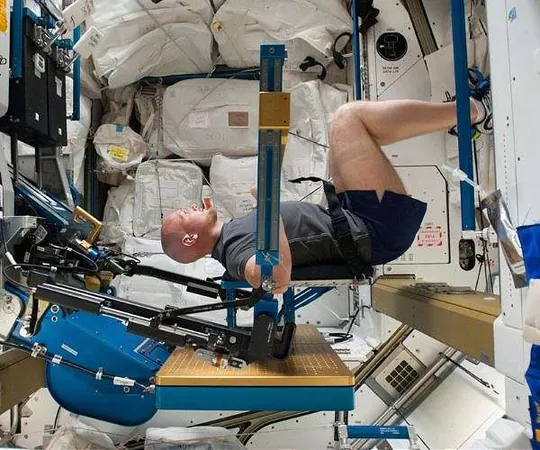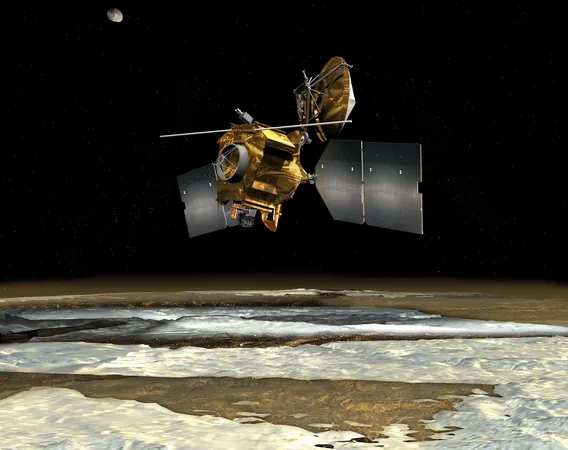
Astronauts Push the Limits of Human Performance in Microgravity
2025-01-19
Author: Nur
Astronauts Push the Limits of Human Performance in Microgravity
As the dawn of 2025 unfolds, many of us contemplate personal improvement goals—be it fitness, skills, or new adventures. Yet, few can compare to the perpetual hustle of astronauts aboard the International Space Station (ISS), where optimizing human performance is a daily mission. These space explorers not only maintain their physical fitness, cognitive acuity, and sensory perception but also adapt to the unique challenges of living in a microgravity environment.
Unveiling the Impact of Microgravity on Cardiovascular Health
The ongoing research by the Canadian Space Agency (CSA) under the Space Health investigation delves into the vital aspects of spaceflight-induced cardiovascular deconditioning. Using innovative wearable technology called Bio-Monitor, which tracks vital signs such as pulse rate and blood pressure, scientists gather crucial data to understand astronauts' health better. The potential for developing an automated system to monitor cardiovascular status could prove revolutionary for long-duration missions to Mars, not only aiding astronauts but also providing insights that could enhance heart health monitoring for people on Earth.
Battling Muscle Atrophy: Innovations in Exercise Science
Gravity aids in muscle maintenance on Earth, but in space, astronauts experience muscle atrophy and stiffness. To combat this, daily exercise regimens are essential. Groundbreaking efforts like the European Space Agency's (ESA) Myotones investigation have pioneered a non-invasive device to accurately assess muscle stiffness during spaceflight. This ability to assess muscle condition in real-time allows researchers to tailor exercise strategies effectively, benefiting the astronaut’s health and potentially translating these technologies to medical facilities on Earth that lack sophisticated monitoring tools.
Sharpening Cognitive Functions
Spaceflight’s strain extends beyond the physical; it also takes a toll on cognitive performance. Factors such as exposure to radiation and sleep deprivation can lead to subtle yet significant impairments in astronauts’ abilities. Recent studies indicate that astronauts may struggle with fine motor control and multitasking right after returning from space. Yet there’s hope. Engaging in simulated tasks shortly post-landing helps combat these deficits, underscoring the need for preparatory practices that could enhance safety during lunar or Martian landings.
Long-duration space missions, such as those lasting six months, have provided a wealth of data suggesting that cognitive functions generally remain stable, with some mild shifts in areas like attention and risk-taking behavior. This research, which boasts the largest sample of professional astronauts studied to date, establishes a baseline to identify cognitive changes and refine countermeasures for future explorations.
The Perception Puzzle: Adapting to Space's Unique Conditions
Sensory perception in microgravity presents its own complexities. A CSA study, known as VECTION, investigated how astronauts interpret motion and distance in space. The outcomes reveal that these individuals retain their ability to perceive object dimensions immediately upon arrival in microgravity, indicating that they can perform essential maneuvers without additional training. Nevertheless, awareness about delayed changes to sensory perception is critical, as unforeseen adaptations may surface over time.
Conclusion: The Future of Space Health
The quest for peak performance in microgravity is not just about survival; it's about thriving in an environment that continuously challenges human norms. As we push the boundaries of exploration beyond Earth, the insights gained will be pivotal—not only for astronauts venturing into deep space but also for enhancing health solutions for our planet's population. The ongoing research offers a glimpse into a future where space travel is safer, and human resilience is pushed to new heights. Fascinatingly, the findings could herald a new era in both space medicine and terrestrial health practices. Stay tuned, as the journey of discovery continues!





 Brasil (PT)
Brasil (PT)
 Canada (EN)
Canada (EN)
 Chile (ES)
Chile (ES)
 Česko (CS)
Česko (CS)
 대한민국 (KO)
대한민국 (KO)
 España (ES)
España (ES)
 France (FR)
France (FR)
 Hong Kong (EN)
Hong Kong (EN)
 Italia (IT)
Italia (IT)
 日本 (JA)
日本 (JA)
 Magyarország (HU)
Magyarország (HU)
 Norge (NO)
Norge (NO)
 Polska (PL)
Polska (PL)
 Schweiz (DE)
Schweiz (DE)
 Singapore (EN)
Singapore (EN)
 Sverige (SV)
Sverige (SV)
 Suomi (FI)
Suomi (FI)
 Türkiye (TR)
Türkiye (TR)
 الإمارات العربية المتحدة (AR)
الإمارات العربية المتحدة (AR)